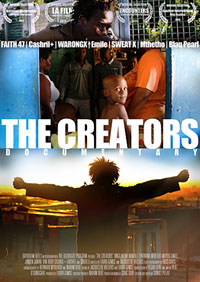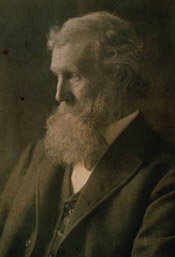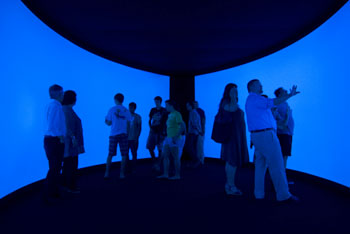The second part of the year-long exhibition “It Happened at Pomona: Art at the Edge of Los Angeles 1969 to 1973, ” began earlier this month, and this part focuses on Helene Winer’s time as museum director from 1970 -72. Winer talked to Art Forum about her Pomona days, when she showed work from Allen Ruppersberg, William Leavitt, Bas Jan Ader, John Baldessari, Chris Burden, William Wegman and many others
Char Miller on the rise of the turkey industry
On his regular blog for KCET, Pomona College Environmental Analysis Professor Char Miller explains how the turkey biz became a multi-billion dollar industry, and then the professor reaches an unsettling conclusion:
Because industrialized agriculture has allowed us to break free from nature’s cyclical hold on our appetite, we’ve gone corpulent. We’ve repeatedly skimmed off the fat of the land and slapped it on our bodies … America the Bloated is a direct result of the global conveyor-belt flow of foodstuffs from factory farm to groaning table. We are what (and how often) we eat.
As a salubrious break from our waist-thickening behavior, as a chance to show our gratitude for having survived our gluttony, perhaps this Thanksgiving we should skip the bird and all its trimmings; even forgo the holiday meal. In short: fast.”
Alumna’s film about South African artists and apartheid’s aftermath lands awards, screenings
Last March, we announced the Los Angeles premiere of The Creators, a documentary about artists in South Africa that Laura Gamse ’07 originally began as her senior thesis project. Since that screening, Gamse’s film has continually racked up awards, screenings and recognition. The film follows six artists—from musicians to visual artists—in modern South Africa, who use their art to re-craft history and the impacts of apartheid in their own unique voices.
 The film has had premieres in South Africa, Germany, Zanzibar, Malaysia and Trinidad and Tobago, in addition to the United States. It will soon premiere at the Bahamas International Film Festival, and in the coming months Gamse will speak and screen the film at Emory University, the University of Colorado and the University of North Carolina. Recently, Gamse presented the film at the San Francisco DocFest and to 100 students from social justice programs in New York City, at a screening/discussion sponsored by HBO and the Museum of Natural History.
The film has had premieres in South Africa, Germany, Zanzibar, Malaysia and Trinidad and Tobago, in addition to the United States. It will soon premiere at the Bahamas International Film Festival, and in the coming months Gamse will speak and screen the film at Emory University, the University of Colorado and the University of North Carolina. Recently, Gamse presented the film at the San Francisco DocFest and to 100 students from social justice programs in New York City, at a screening/discussion sponsored by HBO and the Museum of Natural History.
In September, the National Geographic Society honored The Creators as Best Documentary in its All Roads Film Project, and in August, the World Music and Independent Film Festival named it Best Music Documentary. The National Geographic All Roads blog says “this uplifting film leaves you with a sense of hope” and Huffington Post notes that the film “shows people who refuse to toe the line, whose music will not be silences, who use their art to combat brutality and injustice.”
The work began as Gamse’s thesis, “South African Countercultural Arts at the Fuel of Activism,” which grew out of her self-designed major, Social Activism Through Media and Art. Gamse received a Fulbright grant, which led her to begin filming in South Africa. Says Gamse in our previous article on the project: “I was interested in the protest art that seeped through apartheid’s censors and affected change in South Africa’s various subcultures. I applied for a Fulbright to research the modern day artistic subcultures in South Africa, and this film is the result of two years living and working in Cape Town.”
The film is available on DVD and will soon be available for digital download. View the trailer here.
After 50 years, much to say about John Cage’s “Silence”
The late composer and writer John Cage, who attended Pomona College from 1928 to 1930, gets a substantial treatment in the latest Los Angeles Review of Books. Marjorie Perloff’s piece considers Cage’s Silence, available in a new anniversary edition marking 50 years since its first publication. (Hat tip to laobserved.) Writes Perloff:
“In 1961, Wesleyan University Press published a set of “Lectures and Writings” by John Cage called, simply, Silence. ‘It’s the book I’ve reread most often in my life,’ writes the composer-critic Kyle Gann in his illuminating foreword to the 50th anniversary edition. I know exactly what Gann means: With each rereading, Silence seems as charming and challenging as ever, but also somehow different — not quite what we thought it was.”
More about Cage: Pomona English Professor Dick Barnes wrote about the composer as “Our Distinguished Dropout” in a 1996 issue of PCM.
Professor Miller shines light on John Muir, “The Golden State’s Golden Boy”
 Even if there’s little chance you’ll make it to the exhibition, Professor Char Miller’s blog post about a Bay Area museum’s take on naturalist John Muir is well worth a visit for the deft writing and insight into the life of the man Miller calls “The Golden State’s Golden Boy.”
Even if there’s little chance you’ll make it to the exhibition, Professor Char Miller’s blog post about a Bay Area museum’s take on naturalist John Muir is well worth a visit for the deft writing and insight into the life of the man Miller calls “The Golden State’s Golden Boy.”
Writes Miller: “It was he who gave powerful voice to its wilderness howl, albeit with a Scottish accent. He who cast luminous light on the Sierra, and did so through his legendary tramps through its flowering meadows, along its crystalline rivers, and up into its thin air. In excited prose, he energized Californians and a lot of other Americans to push for the creation of Yosemite National Park (1890) and later for the establishment of the National Park Service (1916). With him as our guide, we’ve scaled such heights.”
More than a decade in the making, play by Alan Brooks ’63 nears off-Broadway debut.
A Splintered Soul, written by Dr. Alan Brooks ’63 and directed by Daisy Walker, will make its off-Broadway debut Oct. 21 in a limited engagement at Theater Three in New York City.
Brooks—who calls himself a “physician by profession and an author by preference”—has spent about a decade writing and developing A Splintered Soul. After retiring from full-time medicine and beginning the project in the late ’90s, Brooks estimates he’s rewritten the play over 100 times. “It took me eight or nine years just to learn how to write a play,” he says. “This version is the same story, but it’s presented in a tighter fashion.” Brooks currently spends much of his time in New York, allowing him to work closely with Walker in the final stages of the play’s production, but still calls Long Beach, Calif. and Homer, Alaska home.

In A Splintered Soul, a group of Jewish refugees arrives in San Francisco in 1947. A fellow Holocaust survivor and former freedom fighter, Rabbi Simon Kroeller, comes to their aid, but in his mission to protect them, he must confront the new moral circumstances they face in the New World. The play’s characters were largely inspired by Brooks’ childhood in the 1940s and ’50s, when many of his surviving relatives emigrated from Europe to America.
“The play presents the opportunity to talk about what’s right and wrong,” says Brooks, “… and how much circumstances can influence that.” When in Los Angeles, where the play was staged at the Odyssey Theater in 2007, Brooks found that many of the people who appreciated the play were immigrants themselves. He wasn’t surprised. “It’s a group of people who are trying to put their lives back together.”
Brooks was profoundly influenced by his own displacement, “the experience of going from one set of circumstances to another,” during the Vietnam War, when he served as a lieutenant commander in the U.S. Navy and then a volunteer physician tending to Vietnamese civilians. When he left this vicious environment—“people getting killed, people getting maimed, people starving,” as he recalls—for a relaxing break in Hong Kong, it was strange to meet Americans at expensive meals and nice hotels. Returning to the combat zone, however, was equally difficult: “They [went] back to their lives, and I went back … to all this chaos and insanity.” Brooks’ experience in Vietnam also inspired a special interest in the developing world that shaped his medical career. He has a degree in tropical medicine and hygiene and, despite being retired, still regularly travels to developing countries to volunteer and teach his specialty, radiology.
After a distinguished and public-spirited career in medicine, it was Brooks’ daughter Lisa who inspired him to pursue the creative arts. After college, when most of her friends went off to medical school or law school, Lisa decided to follow her dream of being a musician, and ended up touring for eight years and releasing half a dozen CDs. “She did it because she wanted to do it,” says Brooks, who has channeled the same passion towards the literary arts. “I’ve always wanted to be a writer,” he says. “Though I enjoyed being a physician … there is no creativity, in a sense. If you get creative as a doctor, you could end up in jail. In art, it’s just the opposite.”
Midnight Surprise at the Museum
Pomona College Museum of Art is open 24/7 through Nov. 6, the end of the first part of the year-long exhibition “It Happened at Pomona: Art at the Edge of Los Angeles 1969 to 1973.” It’s not just students and visitors from near and far who have taken advantage of the chance to experience art in the wee morning hours. So has at least one of the artists whose work is on prominent display, late-night museum security guard Rebecca Vizcarra reported via her iPhone.

Not long after midnight on a recent Saturday morning, three students had just left Tom Eatherton’s Rise, a recreation of his light environment that first appeared at the museum in 1970. And then Eatherton showed up. Vizcarra let the visitors know that the artist was present in case they had any questions for him, and they all went inside Rise. More visitors arrived, and Vizcarra clued them in, too. “Before I knew it there were 19 people including Tom in the exhibit,’’ writes Vizcarra. “I walked in and saw everyone sitting down and looking up at Tom as he was answering their questions and/or conversing. I walked out to my position outside of the exhibit. I walked by in a few minutes later and witnessed a beautiful moment: Everyone including Tom was lying on the floor in complete silence. “
Black surfers gain recognition in “White Wash”
Historian Alison Rose Jefferson ’80 appears in the documentary White Wash , just released on DVD this month, which delves into the rarely-told story of Black surfers.

Jefferson spent years uncovering the history of a stretch of Santa Monica State Beach–labeled the “Ink Well” by some–where the Black community gathered during the decades of de facto segregation in Southern California from the 1920s to the 1950s. When the City of Santa Monica unveiled a plaque in 2008 marking the spot as a “place of celebration and pain,” officials turned to Jefferson for the inscription’s wording, and her research was featured in the fall 2009 (page 39) issue of PCM.
Filmmakers Ted Woods and Airrion Copeland knew of Jefferson’s work and, in the documentary, she discusses the history of the Santa Monica site, the “historic Los Angeles County African-American community’s relationship to the beach” and Nick Gabaldon, the first identified surfer of African American and Mexican descent.
“Film viewers will be surprised to learn that people of color were surfing in Hawaii and Africa long before the California surf culture and Gidget movies brought the sport to American popular culture attention in the 1950s,” says Jefferson. “They will be surprised about the history of the complexities of race in America and water culture as seen through the eyes of the ocean and Black Americans.”
Also featured in the film are many historians and authors along with such surfers as Kelly Slater, Rusty White and Rob Machado. Grammy winner Ben Harper, who has Claremont ties, is narrator.
Still Backing Up The Bard
English Professor Emeritus Martha Andresen, a seven-time winner of Pomona’s Wig Award for excellence in teaching, has been keeping quite busy since her “retirement” in 2006. Pomona Web Editor Laura Tiffany reports the Shakespeare scholar has been lecturing and working on a book, Caught in the Act: A Passion for Shakespeare, among other pursuits. On Oct. 4, the Shakespeare Center of L.A. honored Andresen with a special Crystal Quill Award “for her stellar international reputation for Shakespeare scholarship, publications and teaching.”
Also receiving Crystal Quills were attorney Bert Fields, author of Players: The Mysterious Identity of William Shakespeare, and film director Roland Emmerich, who also has waded into the who-wrote-Shakespeare? debate with his new film Anonymous. “Both Emmerich and Fields suggest that someone other than the celebrated man from Stratford might have written Shakespeare’s plays,” notes LAStageTimes.com.
But Andresen is having none of that, telling Tiffany: “Not the Earl of Oxford, not Frances Bacon, Lord Stanley, or Queen Elizabeth, but William Shakespeare, playwright and actor, wrote William Shakespeare’s plays!”
Shakespeare Center founding Artistic Director Ben Donenberg told LAStageTimes.com that Andresen’s “position that Shakespeare wrote Shakespeare also added a nice dimension to the awardees, but the primary reason is her contribution to the legacy of Shakespeare enthusiasts that she cultivated in many walks of life.”


